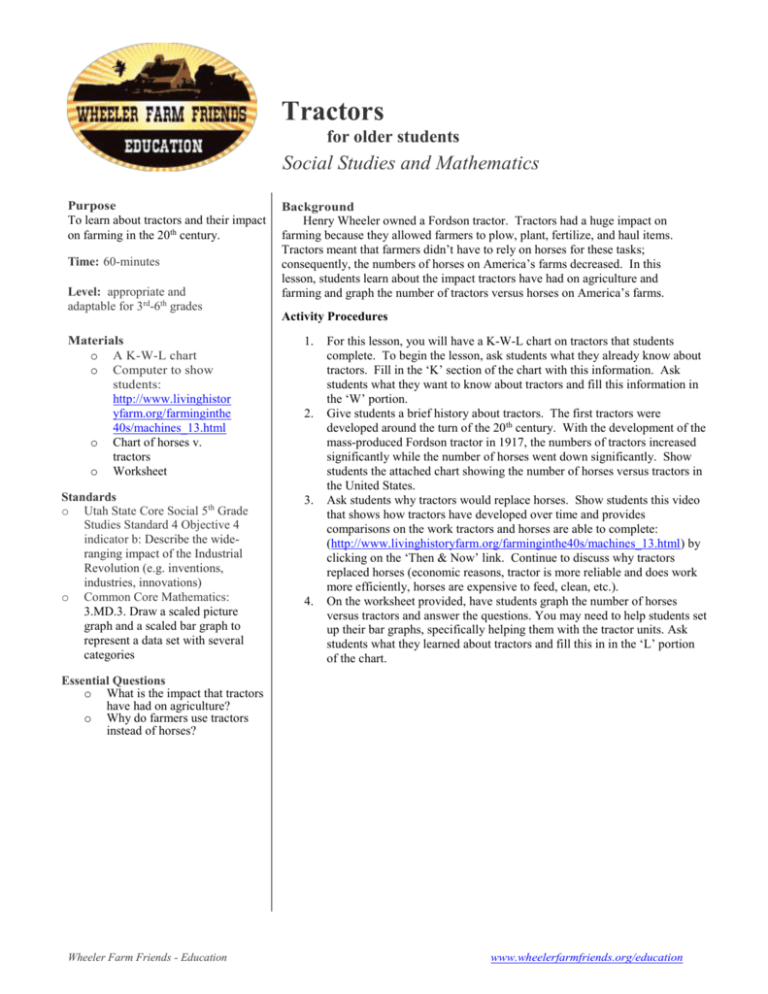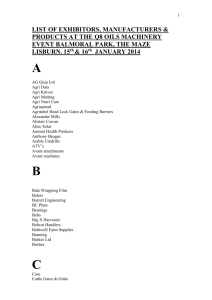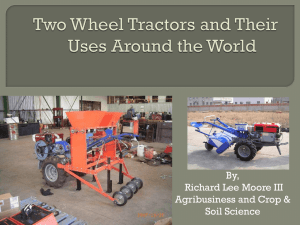Tractors Lesson - Wheeler Farm Friends
advertisement

Tractors for older students Social Studies and Mathematics Purpose To learn about tractors and their impact on farming in the 20th century. Time: 60-minutes Level: appropriate and adaptable for 3rd-6th grades Materials o A K-W-L chart o Computer to show students: http://www.livinghistor yfarm.org/farminginthe 40s/machines_13.html o Chart of horses v. tractors o Worksheet Standards o Utah State Core Social 5th Grade Studies Standard 4 Objective 4 indicator b: Describe the wideranging impact of the Industrial Revolution (e.g. inventions, industries, innovations) o Common Core Mathematics: 3.MD.3. Draw a scaled picture graph and a scaled bar graph to represent a data set with several categories Background Henry Wheeler owned a Fordson tractor. Tractors had a huge impact on farming because they allowed farmers to plow, plant, fertilize, and haul items. Tractors meant that farmers didn’t have to rely on horses for these tasks; consequently, the numbers of horses on America’s farms decreased. In this lesson, students learn about the impact tractors have had on agriculture and farming and graph the number of tractors versus horses on America’s farms. Activity Procedures 1. 2. 3. 4. For this lesson, you will have a K-W-L chart on tractors that students complete. To begin the lesson, ask students what they already know about tractors. Fill in the ‘K’ section of the chart with this information. Ask students what they want to know about tractors and fill this information in the ‘W’ portion. Give students a brief history about tractors. The first tractors were developed around the turn of the 20th century. With the development of the mass-produced Fordson tractor in 1917, the numbers of tractors increased significantly while the number of horses went down significantly. Show students the attached chart showing the number of horses versus tractors in the United States. Ask students why tractors would replace horses. Show students this video that shows how tractors have developed over time and provides comparisons on the work tractors and horses are able to complete: (http://www.livinghistoryfarm.org/farminginthe40s/machines_13.html) by clicking on the ‘Then & Now’ link. Continue to discuss why tractors replaced horses (economic reasons, tractor is more reliable and does work more efficiently, horses are expensive to feed, clean, etc.). On the worksheet provided, have students graph the number of horses versus tractors and answer the questions. You may need to help students set up their bar graphs, specifically helping them with the tractor units. Ask students what they learned about tractors and fill this in in the ‘L’ portion of the chart. Essential Questions o What is the impact that tractors have had on agriculture? o Why do farmers use tractors instead of horses? Wheeler Farm Friends - Education www.wheelerfarmfriends.org/education Wheeler Farm Friends - Education www.wheelerfarmfriends.org/education Name: __________________________________________ Date: __________________________ Tractors Number of horses Number of tractors The invention of the mass produced tractor in 1917 made it possible for farmers to do much of the work on their farm without horses; consequently, the numbers of horses on America’s farms decreased. In the space below, create one bar graph depicting the number of horses over time and another graph depicting the number of tractors over time: Year Year What is the impact that tractors have had on agriculture? _____________________________________ ___________________________________________________________________________________ ___________________________________________________________________________________ Why do farmers use tractors instead of horses? _____________________________________________ ___________________________________________________________________________________ ___________________________________________________________________________________ Wheeler Farm Friends - Education www.wheelerfarmfriends.org/education






